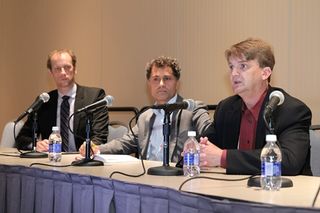Cable-Tec Expo: Energy2020 in 'Show Me the Money' Phase

Get complete coverage of Cable-Tec Expo 2016.
PHILADELPHIA -- The Energy2020 community met on Tuesday at Cable-Tec Expo for its third annual progress report, saying that in “show me the money” terms, the initiative is working. But with only three years or so until the “2020” part of Energy2020, there’s still a ton to do.
“What the SCTE has done with Energy2020 is extremely critical,” said Balan Nair, CTO of Liberty Global and a co-founder of the program. “If we can hit the goals stated, it will make a huge difference -- to us, to our management teams, to our customers.”
The initiative’s four stated goals: To reduce power consumption by 20% (on a per unit basis), cut energy costs by 25% (also on a per unit basis), optimize tech facilities and data centers by 20%, and reduce grid dependency by 10%. All of that, by 2020.
“We’re the engineers … and like any good engineer, you don’t build something for waste,” Nair said.
So far, the savings are small, but poised to grow. Dan Cooper, chair of the SCTE’s Sustainability Management Subcommittee, noted $12.5 million in energy savings since last year, ”which, compared to what we all spend on energy, isn’t a big number, but it’s a start.”
Cooper highlighted two new Charter-initiated efforts since the last E2020 update, both solar: A partnership with two utility companies in upstate New York to provide 12 Megawatts of renewable energy, estimated to save $5-plus million over the life of the project, and a new national data center in Charlotte, N.C., where the use of solar energy will offset 10% in annual energy costs.
Multichannel Newsletter
The smarter way to stay on top of the multichannel video marketplace. Sign up below.
“The key is that it’s not always capital intensive to move the bar” on energy efficiency, he said.
Sam Khola, senior manager of sustainability for Liberty Global, and the recipient of this year’s Energy2020 award, noted that energy costs are “already colossal, and they’re not staying level -- year over year, they grow.” That’s what prompted Liberty’s work with Phase Changing Materials (PCMs) -- a sort of thermal battery that works by capturing and storing a structure’s heat (in this case, hub sites) during the day, then discharging it at night.
“When we talked here last year, it was a tiny implementation in one of the 14 countries we serve,” Khola said. But after they saw a 33% reduction in TCO, and a 43% improvement in energy efficiency, an expansion plan was evident. “The plan is to expand both geographically (beyond the Netherlands, to Ireland and the U.K.), and technologically,” Khola said.
Comcast, which typically experiences 4% growth in annual energy costs, kicked off an overhaul its utility bill management and energy procurement processes, said Daniel Marut, Director of National Sustainability. “With over 200,000 utility accounts, it can be a little overwhelming for an accounts payable team, whose role is to pay the bill,” he said.
That’s what prompted a systematic way of auditing outside plant, to get an accurate count of power supplies, to start. “The idea is to systemically eliminate costs that are incurred by just basic mistakes in utility bill processing,” Marut said.
Pictured left to right: Dan Marut of Comcast, Sam Khola of Liberty Global and Dan Cooper of SCTE. Photo by John Staley for Multichannel News.
